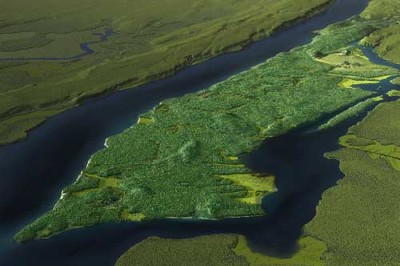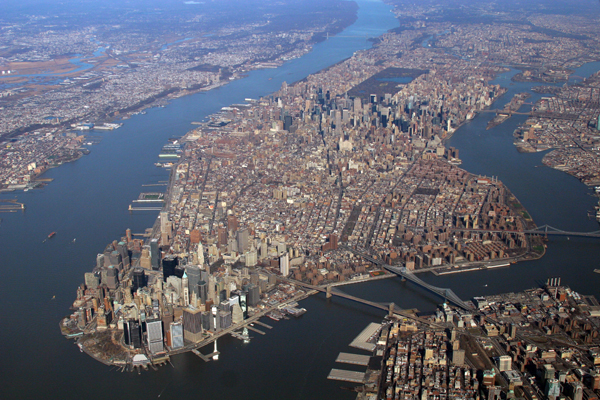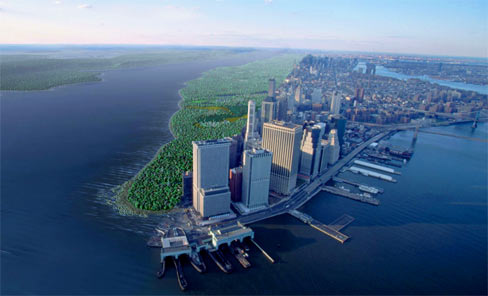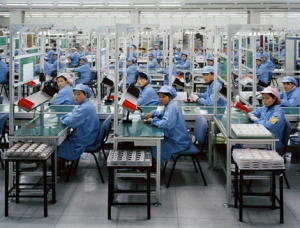Tag: environment
An Interview with Kendra Pierre-Louis
April 22, 2012
 The message was seemingly clear. If we would only swap Mr. Clean for Seventh Generation, switch from old light bulbs to compact fluorescents, and start schlepping our organic groceries in reusable bags, we could reverse the damage we’ve caused the Earth and heal our ailing planet. But according to sustainability expert Kendra Pierre-Louis, our commitment to shopping “green” is only a small first step toward righting our environmental wrongs. In her eye-opening new book Green Washed: Why We Can’t Buy Our Way to a Green Planet, the New York-based environmentalist thoroughly examines the rise of organic food, green housing and clothing, solar power, and the hybrid car before persuasively concluding that the true path to helping the Earth is not buying “green” but buying much, much less. Pointing to America’s growth economy as the main culprit behind our unchecked consumption, Pierre-Louis ultimately advocates for adopting an alternative system that doesn’t pit “our short-term well-being against our long term survival.” In honor of Earth Day, we recently spoke to Ms. Pierre-Louis via email about nature in New York City, the “IKEA effect,” alternative economies, the importance of community engagement, and how she plans to celebrate today.
The message was seemingly clear. If we would only swap Mr. Clean for Seventh Generation, switch from old light bulbs to compact fluorescents, and start schlepping our organic groceries in reusable bags, we could reverse the damage we’ve caused the Earth and heal our ailing planet. But according to sustainability expert Kendra Pierre-Louis, our commitment to shopping “green” is only a small first step toward righting our environmental wrongs. In her eye-opening new book Green Washed: Why We Can’t Buy Our Way to a Green Planet, the New York-based environmentalist thoroughly examines the rise of organic food, green housing and clothing, solar power, and the hybrid car before persuasively concluding that the true path to helping the Earth is not buying “green” but buying much, much less. Pointing to America’s growth economy as the main culprit behind our unchecked consumption, Pierre-Louis ultimately advocates for adopting an alternative system that doesn’t pit “our short-term well-being against our long term survival.” In honor of Earth Day, we recently spoke to Ms. Pierre-Louis via email about nature in New York City, the “IKEA effect,” alternative economies, the importance of community engagement, and how she plans to celebrate today.
Online Librarian Flooded with Response to Booksharing Concept
October 19, 2010
 A British founder of an online book sharing service has been swamped with people calling to join his project. Peter Baillie has received over 700 requests to share in his scheme! The plan works like this: for a nominal annual fee (8.95 pounds) each member must be able to share 10 paperback books that are in good condition. Each person is responsible to pack and ship his items. The hope is that people will be able to reduce the number of books they buy and save resources. The website My Book Your Book was to go live Aug. 22, 2010.
A British founder of an online book sharing service has been swamped with people calling to join his project. Peter Baillie has received over 700 requests to share in his scheme! The plan works like this: for a nominal annual fee (8.95 pounds) each member must be able to share 10 paperback books that are in good condition. Each person is responsible to pack and ship his items. The hope is that people will be able to reduce the number of books they buy and save resources. The website My Book Your Book was to go live Aug. 22, 2010.
My questions- Do you think arrangements such as this one could ever impact traditional libraries? Is it a good idea or not?
Shira S.
Libraries and Librarians in the News
July 6, 2010
 Where it’s unsafe to be outside, libraries provide haven for kids
Where it’s unsafe to be outside, libraries provide haven for kids
————————————————–
Chicago Tribune (IL)-July 6, 2010
Author: Lolly Bowean, Tribune reporter
It was a warm and sunny day outside, but Xavier Parker, 10, was deep into a computer game at Thurgood Marshall Public Library when his father walked in and told the boy he was about to go to a store.
“Stay in here,” Xavier’s father, Jimmy Giles, said, leaving the boy in charge of his 6- and 8-year-old brothers. “Don’t go anywhere until I come back and get you.” Continue reading “Libraries and Librarians in the News”
Wendell Berry Burned Up By Coal
July 3, 2010
 If one knows anything for certain about writer Wendell Berry, it is that he is a man of ideals and deeply held convictions. Throughout his long career spanning countless novels, short stories, poems, and essays Berry has written extensively about what he believes constitutes a life worth living. Key among Berry’s beliefs is the idea that life and land are interconnected and integral to happiness and well-being. The author, who is also a longtime farmer, is well known for his beliefs in the benefits (ecological, economic, spiritual) of an agrarian way of life, and has long argued that a return to a more agrarian-based culture is necessary for the health of our society. He is extraordinarily cautious, even wary, of much of modern technology and the threats it poses to humanity in terms of industrialization and environmental destruction. So it should come as little surprise to any thinking or reasoning person that Mr. Berry was a bit heated upon finding that the University of Kentucky (Berry’s alma mater and recipient of his enormous collection of personal archives) had decided to name its new athletic dorm the Wildcat Coal Lodge in a nod to the school’s coal industry donors. Continue reading “Wendell Berry Burned Up By Coal”
If one knows anything for certain about writer Wendell Berry, it is that he is a man of ideals and deeply held convictions. Throughout his long career spanning countless novels, short stories, poems, and essays Berry has written extensively about what he believes constitutes a life worth living. Key among Berry’s beliefs is the idea that life and land are interconnected and integral to happiness and well-being. The author, who is also a longtime farmer, is well known for his beliefs in the benefits (ecological, economic, spiritual) of an agrarian way of life, and has long argued that a return to a more agrarian-based culture is necessary for the health of our society. He is extraordinarily cautious, even wary, of much of modern technology and the threats it poses to humanity in terms of industrialization and environmental destruction. So it should come as little surprise to any thinking or reasoning person that Mr. Berry was a bit heated upon finding that the University of Kentucky (Berry’s alma mater and recipient of his enormous collection of personal archives) had decided to name its new athletic dorm the Wildcat Coal Lodge in a nod to the school’s coal industry donors. Continue reading “Wendell Berry Burned Up By Coal”
Some Verse for the Earth
April 22, 2010
 If after waking this morning you noticed a palpable buzz in the air, fear not for your senses do not deceive you and your coffee is not to blame. Today is simply a big day. As you are almost certainly aware after three weeks of non-stop poetic feasting, National Poetry Month is still going strong. What’s more, today is Earth Day, and when two celebrations of this magnitude converge, the resulting super holiday demands proper commemoration. Thankfully, we have the wonderfully unique poetry collection News of the Universe with which to mark this worthy occasion. Whether you’re looking to motivate your first reducing, reusing, and recycling efforts, to renew your vow to live a leaner, greener lifestyle, or to simply read some breathtaking poetry, News of the Universe is a book that will leave you awestruck and inspired.
If after waking this morning you noticed a palpable buzz in the air, fear not for your senses do not deceive you and your coffee is not to blame. Today is simply a big day. As you are almost certainly aware after three weeks of non-stop poetic feasting, National Poetry Month is still going strong. What’s more, today is Earth Day, and when two celebrations of this magnitude converge, the resulting super holiday demands proper commemoration. Thankfully, we have the wonderfully unique poetry collection News of the Universe with which to mark this worthy occasion. Whether you’re looking to motivate your first reducing, reusing, and recycling efforts, to renew your vow to live a leaner, greener lifestyle, or to simply read some breathtaking poetry, News of the Universe is a book that will leave you awestruck and inspired.
Have You Read . . . ?
September 18, 2009

If the lush green island above looks strangely familiar, that’s because you’ve undoubtedly seen it many times before. Although if you’re having trouble placing just how you know this beautiful wild landscape, that’s because you’re probably used to seeing it look more like this:

Of course you know that the second picture is Manhattan Island as it looks today, the bustling hub of New York City. But the first picture above is the same island, Mannahatta or “Island of Many Hills,” (as it was called by local Native Americans) circa 1609.
For the past ten years the scientific researchers at the Mannahatta Project have been painstakingly recreating what the island would have looked like prior to the arrival of Henry Hudson and his crew on September 12, 1609. When the New World came calling, the island of Mannahatta was an amazingly diverse and abundant natural landscape, with more ecological communities, plant species, and birds than today’s Yellowstone, Yosemite, and Great Smoky Mountains National Parks. In addition to housing numerous large mammals, fish, and other wildlife, the island was also home to the Lenape tribe of people. In the 400 years since Hudson’s arrival, Mannahatta gave way to Manhattan, cultural diversity replaced biodiversity, and economic wealth replaced ecological wealth as the land that once existed was rendered virtually unrecognizable. Until now, that is. Over the past decade, the Mannahatta Project has been digitally rebuilding the land of yesterday by analyzing soil records, geography, rivers and wetlands, maps, descriptions of long disappeared plant and animal life, as well as by studying the landscape of the island today. The project is extensive in its research and astounding in its results.

You can explore the island past and present in extensive detail in the new book Mannahatta: a Natural History of New York City. Inside you’ll find a full explanation of the science behind the project, detailed descriptions of just what the researchers discovered about the island, and a look forward to what Manhattan might look like 400 years from now. All of this is accompanied by numerous stunning illustrations of what the researchers believe Mannahatta to have looked like long ago, as well as amazing side by side comparisons of various spots around the city as they look now and how they would have appeared in 1609.
And for a more distilled and interactive look at the project, check out the very cool Mannahatta Project website. As the project researchers believe, by looking backwards into the past, perhaps we can glimpse a new ecological vision for the future.
Attempting to Tread Lightly
July 24, 2009
 About two weeks ago, I watched the documentary, Manufactured Landscapes. It follows Canadian photographer Edward Burtynsky around the globe and examines his beautiful photographs of the seldom seen consequences of globalization (read a full review here). At first while watching the movie I found the images of gigantic factories and mountains of industrial waste to be completely spellbinding and otherworldly. Because I was watching a movie (a medium in which we’re used to seeing completely unreal images projected before us for our amazement), I was just sort of mesmerized by these incredible, impossible seeming images as though they were merely pictures conjured up in a Hollywood studio using the latest computer generated digital imaging techniques. But slowly it began to dawn on me that these unreal images were actually completely real. And the fact that they seemed otherworldly to me was because those scenes do exist in a completely different world than the one we, as Westerners inhabit on a daily basis. But what affected me most about these images was the realization that we, that I, am in part to blame for this horrific treatment of the earth and our fellow human beings.
About two weeks ago, I watched the documentary, Manufactured Landscapes. It follows Canadian photographer Edward Burtynsky around the globe and examines his beautiful photographs of the seldom seen consequences of globalization (read a full review here). At first while watching the movie I found the images of gigantic factories and mountains of industrial waste to be completely spellbinding and otherworldly. Because I was watching a movie (a medium in which we’re used to seeing completely unreal images projected before us for our amazement), I was just sort of mesmerized by these incredible, impossible seeming images as though they were merely pictures conjured up in a Hollywood studio using the latest computer generated digital imaging techniques. But slowly it began to dawn on me that these unreal images were actually completely real. And the fact that they seemed otherworldly to me was because those scenes do exist in a completely different world than the one we, as Westerners inhabit on a daily basis. But what affected me most about these images was the realization that we, that I, am in part to blame for this horrific treatment of the earth and our fellow human beings.
 I haven’t been able to shake off these thoughts since watching the movie. I’ve been obsessively checking the tags on all my clothing and turning everything I own upside down, looking to see where things were made. Without fail, everything was manufactured overseas: China, India, Vietnam, etc. With each new tag I read, my heart sank a little more as I wondered under what conditions these goods had been produced.
I haven’t been able to shake off these thoughts since watching the movie. I’ve been obsessively checking the tags on all my clothing and turning everything I own upside down, looking to see where things were made. Without fail, everything was manufactured overseas: China, India, Vietnam, etc. With each new tag I read, my heart sank a little more as I wondered under what conditions these goods had been produced.
 This week I went shopping for a new pair of sneakers with all of these thoughts in mind. In store after store, and website upon website, I kept running up against shoes made overseas, usually in China. Even searches for small, supposedly ethically produced shoes led to manufacturing plants in China. I conducted what I consider to be a fair amount of research before buying a product, and nowhere was I able to find a sneaker whose origins I didn’t have at least some misgivings about. I finally settled on a shoe (made in China), which claims to be made from 100% recycled and sustainable materials (old car tires, plastic bottles, bamboo, hemp, etc.) and whose website alleged that all their products were manufactured according to legal (if not ethical) guidelines. I made the purchase, because I wasn’t sure what better alternatives existed, even though I questioned the trustworthiness of this (multimillion dollar) company’s claims. The sad fact of the matter was that they were the best ethical option I could find, but with each step in my new shoes I wonder: is this the best we can do?
This week I went shopping for a new pair of sneakers with all of these thoughts in mind. In store after store, and website upon website, I kept running up against shoes made overseas, usually in China. Even searches for small, supposedly ethically produced shoes led to manufacturing plants in China. I conducted what I consider to be a fair amount of research before buying a product, and nowhere was I able to find a sneaker whose origins I didn’t have at least some misgivings about. I finally settled on a shoe (made in China), which claims to be made from 100% recycled and sustainable materials (old car tires, plastic bottles, bamboo, hemp, etc.) and whose website alleged that all their products were manufactured according to legal (if not ethical) guidelines. I made the purchase, because I wasn’t sure what better alternatives existed, even though I questioned the trustworthiness of this (multimillion dollar) company’s claims. The sad fact of the matter was that they were the best ethical option I could find, but with each step in my new shoes I wonder: is this the best we can do?
Watch the trailer for Manufactured Landscapes below. It is a difficult film to watch, because it poses difficult questions. But ultimately, these are questions we all need to be asking in a conversation which must be had.
[youtube=http://www.youtube.com/watch?v=Jv23xwe0BoU]